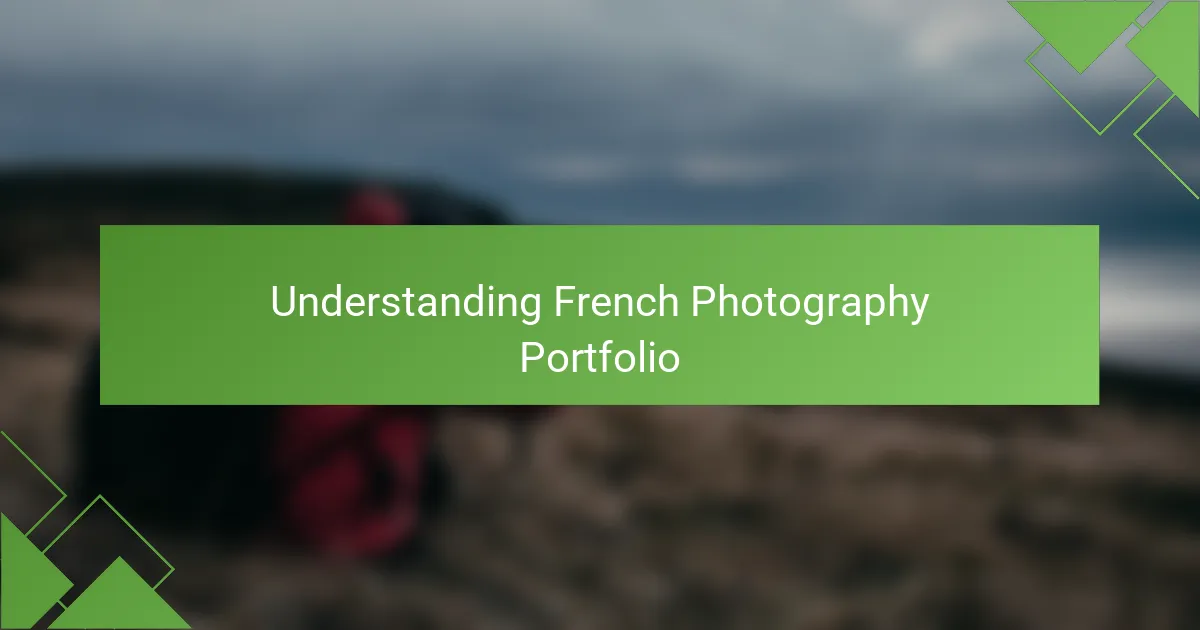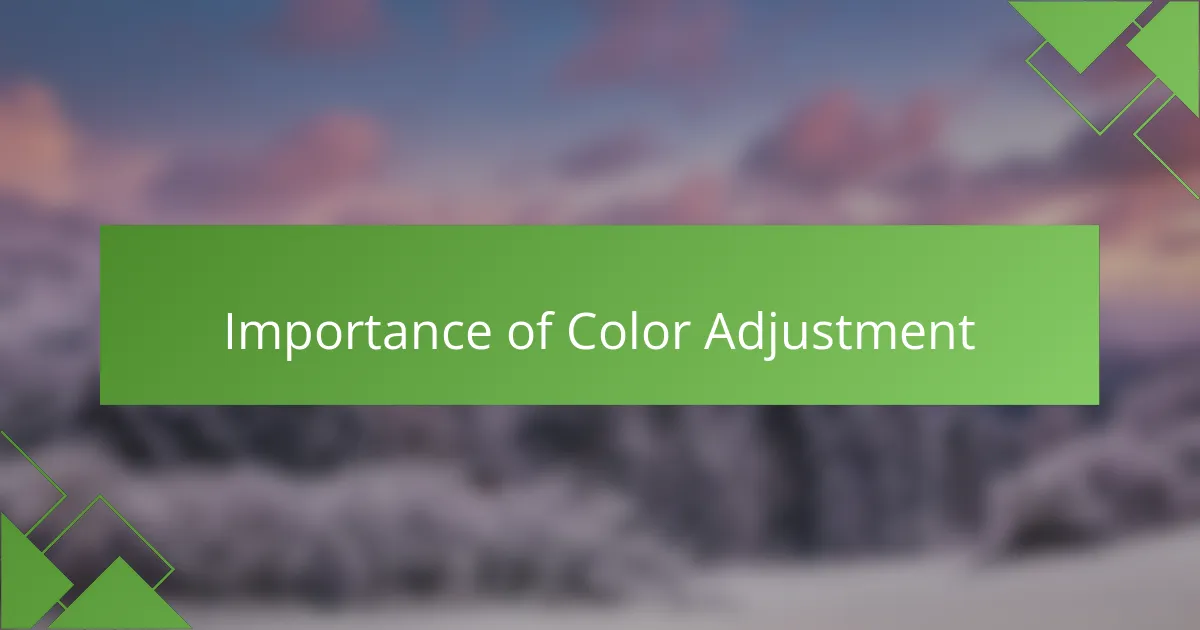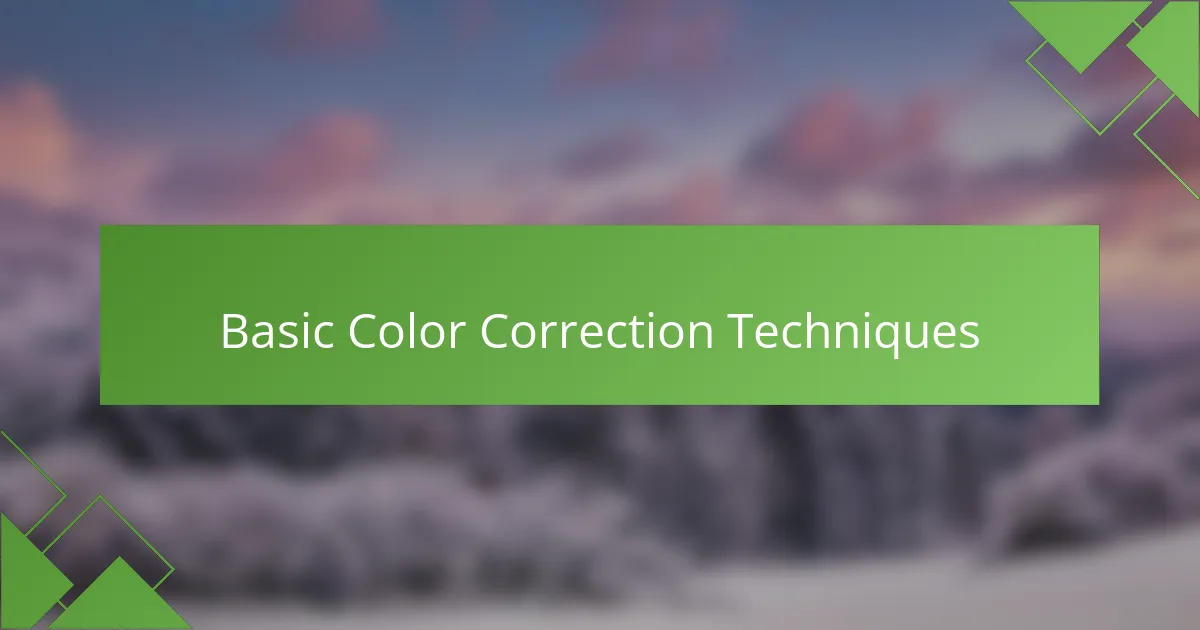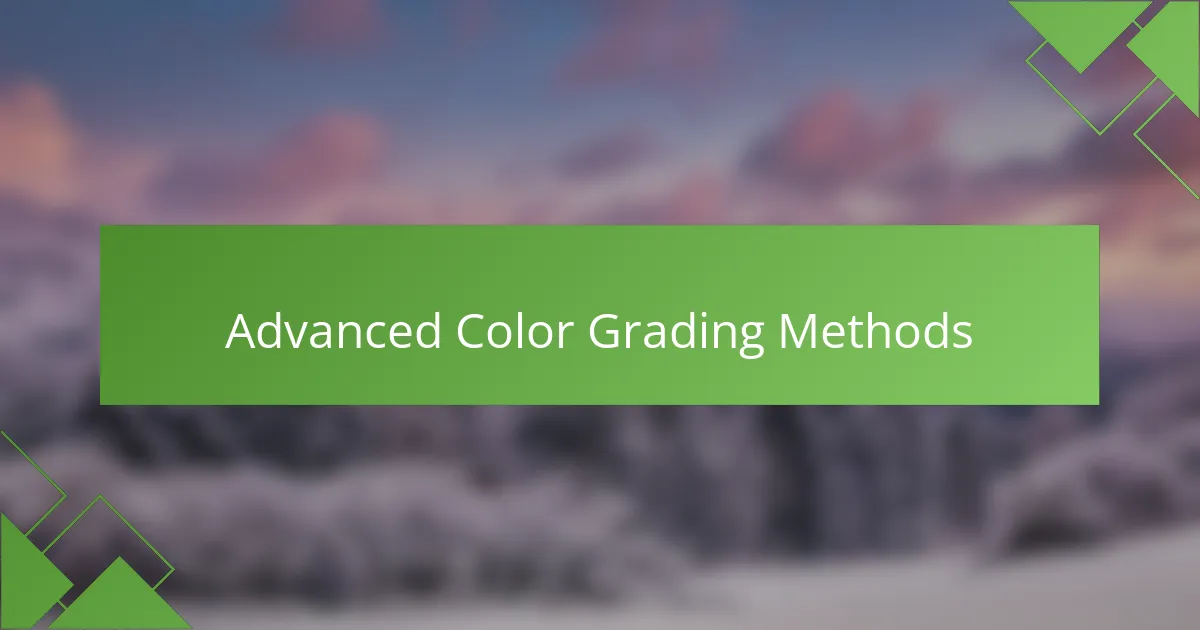Key takeaways
- French photography blends cultural heritage with contemporary themes, using color to enhance emotional storytelling.
- Color adjustment techniques in photography, such as contrast and saturation, are crucial for evoking emotions and improving image quality.
- DaVinci Resolve offers advanced tools for both color grading and video editing, allowing for precise control in storytelling through visuals.
- Integrating color adjustments into a photography portfolio enhances mood and reflects the artist’s unique voice, transforming viewer perceptions.

Understanding French Photography Portfolio
Understanding the French photography portfolio is essential for anyone wanting to appreciate the unique blend of artistry and history in this work. French photographers often draw inspiration from their rich cultural heritage, intertwining it with contemporary themes that speak to both emotion and experience. Personally, I find that the storytelling aspect behind each photograph captures the essence of French life, making every portfolio a captivating narrative.
When I explore a French photography portfolio, I often notice how color plays a pivotal role in conveying mood and atmosphere. This visual language can evoke nostalgia or highlight the beauty of everyday moments, and it’s truly remarkable how a single hue can change the entire perception of an image.
Here’s a comparison table that encapsulates some key elements of French photography portfolios:
| Element | Description |
|---|---|
| Color Usage | Emphasis on emotional impact and storytelling. |
| Subject Matter | Often includes cultural themes and personal narratives. |
| Technique | Combines traditional and modern photographic methods. |

Importance of Color Adjustment
Color adjustment plays a crucial role in photography, as it can dramatically influence the mood and narrative of an image. I’ve often found that a slight tweak to the color balance can transform a dull photo into something vibrant and captivating. It’s like adding a personal touch to your work, giving each image its unique voice.
When I first started adjusting colors in DaVinci Resolve, I was amazed at how much control I had over the final look. For instance, fine-tuning the contrast can create a more dramatic effect, while enhancing saturation can evoke strong emotions from viewers. This process allows us to resonate with our audience, making our photographs not just seen, but felt.
Here’s a simple comparison of basic color adjustments you might make in DaVinci Resolve:
| Adjustment | Effect |
|---|---|
| Contrast | Enhances the difference between light and dark areas, creating depth. |
| Saturation | Increases the intensity of colors, making them more vibrant. |
| Hue | Shifts colors on the color spectrum, altering their overall appearance. |

Overview of DaVinci Resolve
DaVinci Resolve is a powerhouse in the realm of color grading and video editing. This software combines advanced capabilities with a user-friendly interface, making it accessible for both beginners and seasoned professionals. I remember the first time I opened it; the sheer array of tools left me feeling both excited and a bit overwhelmed. It was like stepping into a digital artist’s studio, where everything was possible.
One of the standout features of DaVinci Resolve is its node-based workflow, which allows for precise control over each element of the image. This flexibility aligns perfectly with my creative vision. For instance, being able to manipulate specific color channels independently has helped me to express the emotions I want to evoke in my photography. Have you ever felt that one little tweak could change the entire storytelling of your image? In my experience, it truly can.
Another aspect that sets DaVinci Resolve apart is its robust integration of editing and color grading into one platform. I often find myself seamlessly switching between cutting clips and adjusting tonal quality as I craft my final piece. This holistic approach not only enhances efficiency but also ensures that my creative vision remains coherent throughout the project.

Basic Color Correction Techniques
When it comes to basic color correction techniques, one essential step is adjusting the exposure. I’ve learned that a well-exposed photo can breathe life into the scene, allowing shadows and highlights to play nicely with each other. Have you ever found a photo that felt too dark or washed out? A quick tweak to the exposure can reveal hidden details and make the image more inviting.
Another technique I frequently apply is white balance adjustment. I remember struggling with images that appeared too warm or too cool, which completely altered the scene’s mood. By adjusting the temperature and tint sliders in DaVinci Resolve, I can bring back the natural colors of my subjects. It’s fascinating how a simple shift can transform an uninspiring shot into something that feels genuine and true to life.
Lastly, playing with the vibrance setting has become one of my go-to methods. I often find that boosting vibrance restores color richness without overwhelming the image. This technique is perfect for portraits, where I want the subject’s skin tones to still look natural. By carefully applying this adjustment, I feel like I’m enhancing the photo’s story while ensuring my subjects shine.

Advanced Color Grading Methods
When it comes to advanced color grading in DaVinci Resolve, I’ve found that utilizing tools like the Color Wheel and Curves can really elevate the look of my footage. For instance, I remember working on a soft landscape shot where adjusting the shadows and highlights allowed me to bring out the subtle textures in the clouds. It’s often those minor adjustments that can transform a good image into a stunning one.
Another technique I frequently rely on is the use of Power Windows for selective color grading. I vividly recall a portrait shoot where I needed the background to recede while keeping my subject vibrant. By creating a Power Window around the subject, I was able to enhance the colors in a way that drew the viewer’s attention exactly where I wanted it to go. Such tactics make all the difference in creating a more dynamic and engaging visual story.
Here’s a quick comparison table to illustrate some advanced color grading methods I often use:
| Method | Description |
|---|---|
| Color Wheels | Adjust overall color balance using highlights, midtones, and shadows. |
| Curves | Modify color channels precisely to enhance contrast and color distribution. |
| Power Windows | Isolate specific areas in your frame to apply targeted color adjustments. |

Integrating Colors into Your Portfolio
Integrating color adjustments into your photography portfolio can significantly enhance the mood and storytelling of your images. From my experience, a well-graded photo can evoke emotions that bring a viewer closer to the subject. For instance, adjusting the warmth of colors can create a cozy, inviting atmosphere, while cooler tones might evoke a sense of calm or melancholy.
In my journey, I’ve learned that subtle color changes can sometimes make a world of difference. Think about how a soft, golden hue can transform a sunset photograph into a dramatic masterpiece. Balancing these colors not only elevates the visual quality but also reflects your unique artistic voice.
When I started experimenting with color grading in DaVinci Resolve, I was amazed at how the right adjustments could completely alter the narrative of my images. Here’s a quick comparison of color adjustment impacts:
| Color Adjustment | Emotional Impact |
|---|---|
| Warm Tones | Inviting, Nostalgic |
| Cool Tones | Calm, Reflective |
| High Contrast | Dramatic, Bold |
| Pastel Shades | Soft, Serene |

Showcasing Final Results Effectively
When showcasing final results in DaVinci Resolve, it’s essential to present your work in a way that captivates the viewer. I often find that the differences in color grading can evoke various emotions when they are seen side by side. For instance, a vibrant, high-contrast look can energize a scene, while softer pastel tones can create a serene atmosphere. I remember the first time I compared two different color grades of the same shot; it was astonishing how much the mood shifted, almost like viewing two entirely different stories.
Creating visual comparisons is key. I typically use the split-screen feature to highlight adjustments effectively, allowing viewers to see the transformation clearly. This not only emphasizes the skill involved but also helps communicate the emotional impact of color choices.
| Original Color Grade | Adjusted Color Grade |
|---|---|
| Muted tones, low contrast | Vibrant colors, high contrast |
| Flat image, less depth | Rich shadows, dynamic highlights |